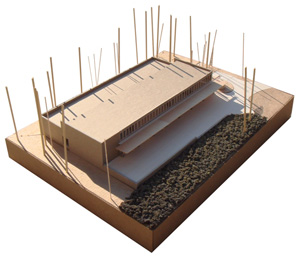| Green Oyster Hatchery Research Facility Begins Construction
by Russell Boniface
Associate Editor
Summary: Raleigh-based Frank Harmon Architect PA has designed a sustainable Oyster Hatchery Research facility to be sited on the Coastal Marine Sciences campus at the University of North Carolina (UNC)–Wilmington. Construction of the 12,000-square-foot green Oyster Hatchery Research facility began last month. Construction is expected to be completed by May 2010.

The Oyster Hatchery Research facility is sited in a marine forest on the Coastal Marine Sciences campus at University of North Carolina (UNC)—Wilmington. Image courtesy of Frank Harmon Architect PA..
In 2006, the North Carolina Aquarium Division asked Frank Harmon Architect PA to participate in a feasibility study for three green oyster hatchery facilities to be located along the North Carolina coast. The study, funded by the Aquarium Division, looked at establishing oyster hatcheries to re-establish the state’s oyster population and to clean coastal waters. The Oyster Hatchery Research facility on the Coastal Marine Sciences campus at UNC–Wilmington is the first phase of implementing that study. The pilot facility is part of the North Carolina Division of Marine Fisheries.
The state’s three future oyster hatchery facilities would produce billions of oysters to help reestablish the state’s oyster population. According to the study, the oyster population in North Carolina has declined due to habitat loss, decline of water quality, diseases, and over-harvesting. When the oyster population was at its peak, for example, entire estuaries like the Pamlico Sound were filtered and cleaned in a matter of days.
The Oyster Hatchery Research facility being built on the Coastal Marine Sciences campus at UNC-Wilmington is the first phase of implementing the study and is in accord with the North Carolina Department of Environment and Natural Resources’ policy requiring sustainable and green building practices wherever feasible for state-owned buildings.

North Carolina’s three future oyster hatchery facilities would produce billions of oysters to help reestablish the state’s oyster population and to clean coastal waters. Image courtesy of Frank Harmon Architect PA..
The hatchery process; a conservation effort
Simply put, the Oyster Hatchery will line oysters in a row from which they will lay eggs, says Frank Harmon, FAIA. “The goal is to create new oysters,” he says. “A single oyster can produce about 100,000 eggs. The survival rate is at best one in a million. The hatchery process is a way of getting a better return. The oysters reproduce, and you gather the eggs and get them to attach themselves to something solid under the water, ideally an oyster shell. You grow them for several weeks until they get larger. It’s called oyster spat. Your goal is to take those and broadcast them out over existing oyster beds.”
Harmon calls the process a conservation effort. “In North Carolina the number one endangered habitat is our sounds,” he says. “A hundred years ago we had the most productive estuary on the east coast for oysters. Three things happened: they got over-harvested, water pollution, and the oyster reefs got eliminated. Production now is 5 percent of what it was 100 years ago.”
Sustainable design
The Oyster Hatchery site needed to have clean water. “We found really clean water in Wilmington, also on a site owned by the state of North Carolina,” Harmon says. The hatchery is also sited in a marine forest of oak trees. “It is a sustainable building with daylight and natural ventilation, and it collects rainwater. We thought it was important for this project to make the building as sustaining as possible.” Design materials include steel and brick, matching the predominately brick UNC-W campus. Recycled materials are also being incorporated.
|



